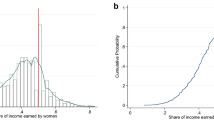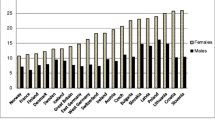Abstract
The current study attempts a simultaneous testing of economic models, the gender display perspective, and gender-deviance neutralization hypothesis that attempt to explain present housework arrangements between men and women. The study uses fixed effects models that can produce more robust coefficients than the standard regression models generally used in cross-sectional designs. The findings in the study reveal the inadequacy of economic models and the gender display theory to account for men’s housework behavior. The study introduces the marital contract hypothesis as an alternative theoretical framework for explaining men’s housework behavior. According to the study, what is crucial for achieving housework parity is changes in women’s gender related attitudes and their economic and labor market standing and orientation to paid work. The study suggests that attempting to change men’s gender beliefs can do little to achieve the goal of housework parity.


Similar content being viewed by others
References
Acker, J. (1988). Class, gender, and the relations of distribution. Signs, 13, 473–497.
Berk, S. F. (1985). The gender factory: The apportionment of work in American households. New York: Plenum.
Bittman, M., England, P., Folber, N., Sayer, L., & Matheson, G. (2003). When does gender trump money? Bargaining and time in household work. The American Journal of Sociology, 109(1), 186–214.
Brayfield, A. A. (1992). Employment resources and housework in Canada. Journal of Marriage and the Family, 54, 19–30.
Brines, J. (1993). Economic dependency, gender, and the division of labor at home. American Journal of Sociology, 100, 652–688.
U.S. Census (2011). http://www.census.gov/compendia/statab/2011/tables/11s0585.pdf.
Cohen, P. N. (1998). Replacing housework in the service economy. Gender & Society, 12(2), 219–231.
Coltrane, S. (2000). Research on household labor: Modeling and measuring the social embeddedness of routine family work. Journal of Marriage and the Family, 62, 1208–1233.
Ferree, M. M. (1991). The gender division of labor in two-earner marriages: Dimensions of variability and change. Journal of Family Issues, 12, 158–180.
Greenstein, T. N. (2000). Economic dependence, gender and the division of labor in the home: A replication and extension. Journal of Marriage and the Family, 62, 322–335.
Gupta, S. (2007). Autonomy, dependence, or display? The relationship between married women’s earnings and housework. Journal of Marriage and Family, 69(2), 399–417.
Hartmann, H. (1981). The unhappy marriage of marxism and feminism: Towards a more progressive union. In L. Sargent (Ed.), Women and revolution. Boston: South End Press.
Hochschild, A., & Machung, A. (1989). The second shift: Working parents and the revolution at home. New York: Viking.
Huckfeldt, R. R. (1986). Politics in context: Assimilation and conflict in urban neighborhoods. New York: Agathon Press.
John, D., & Shelton, B. A. (1997). The production of gender among black and white women and men: The case of household labor. Sex Roles, 36, 171–193.
Leidner, Robin. (1991). Serving hamburgers and selling insurance: Gender, work, and identity in interactive service jobs. Gender & Society, 5(4), 154–177.
Marini, M. M., & Fan, P. (1997). The gender gap in earnings at career entry. American Sociological Review, 62, 588–604.
McHale, S. M., & Crouter, A. C. (1992). You can’t always get what you want: Incongruence between sex-role attitudes and family work roles and its implications for marriage. Journal of Marriage and the Family, 54, 537–547.
Moore, L. M., & Vanneman, R. (2003). Context matters: Effects of the proportion of fundamentalists on gender attitudes. Social Forces, 82(1), 115–139.
Noonan, M. C. (2001). The impact of domestic work on men’s and women’s wages. Journal of Marriage and Family, 63, 1134–1145.
Orbuch, T. L., & Custer, L. (1995). The social context of married women’s work and its impact on Black Husbands and White Husbands. Journal of Marriage and the Family, 57, 333–345.
Pierce, Jennifer. (1995). Gender trials: Rambo litigators and mothering paralegals. In Rambo litigators: Emotional labor in a male-dominated job (pp. 50–82). Berkeley: University of California Press.
Pressor, H. B. (1994). Employment schedules among dual-earner spouses and the division of household labor by gender. American Sociological Review, 59, 348–364.
Robinson, J., & Godbey, G. (1997). Time for life. University Park, PA: Pennsylvania State University Press.
Ross, C. E. (1987). The division of labor at home. Social Forces, 65(3), 816–833.
Soberon-Ferrer, H., & Dardis, R. (1991). Determinants of household expenditures for services. Journal of Consumer Research, 17(4), 385–397.
West, C., & Fenstermaker, S. (1993). Power and the accomplishment of gender. In P. England (Ed.), Theory on gender/feminism on theory (pp. 151–174). New York: Aldine deGruyter.
West, C., & Zimmerman, (1987). Doing gender. Gender & Society, 1(2), 125–151.
Acknowledgments
I would like to thank Rachel Gordon, Cedric Herring, David Rubinstein, and anonymous reviewers for their helpful comments on this manuscript.
Author information
Authors and Affiliations
Corresponding author
Rights and permissions
About this article
Cite this article
Vijayasiri, G. The Allocation of Housework: Extending the Gender Display Approach. Gend. Issues 28, 155–174 (2011). https://doi.org/10.1007/s12147-011-9103-6
Published:
Issue Date:
DOI: https://doi.org/10.1007/s12147-011-9103-6




